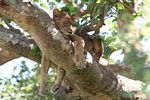|
|
In 1515 Leonardo Da Vinci, artist and engineer, invented a mechanical lion that was given as a gift to Francois I, then King of France. The original was lost, but a new model has been crafted in Amboise, France by Renato Boaretto.
Providing a window into the past,the new robotic lion is based on drawings and plans for other Da Vinci mechanics, since no sketches exist of the lion that entertained the king. The model is life-size. When wound by hand the lion is able to walk, open its mouth, move its tail, and shake its head.
By the 16th Century—when Da Vinci crafted his lion—the lion had been extinct in Europe for nearly one-thousand five hundred years, though it once roamed the Mediterranean, even including southern France. However, during the Renaissance the lion still survived in Northern Africa and the Middle East.
Today, lions survive mostly in sub-Saharan Africa, but are rapidly declining for reasons not fully understood by biologists. The species is listed as Vulnerable by the IUCN.
The lion was chosen by Da Vinci because it was the symbol of the French monarchy.
Video of the lion, courtesy of Reuters: http://www.youtube.com/watch?v=xNWE2AdfNuo
Related articles
Giant population of lions could live war-torn region
(01/30/2009) The war-torn frontier between Uganda and the Democratic Republic of the Congo has prey to support more than 900 lions, but conservationists must act soon to protect the big cats from poaching and poisoning by livestock herders, report researchers writing in the journal Oryx. The study, which was conducted by Adrian Treves of the University of Wisconsin-Madison and colleagues from Wildlife Conservation Society and the Panthera Foundation, relied on aerial surveys of lion prey — buffalo, warthog, waterbuck and other ungulates — which were then used to estimate the region’s potential lion population.
20 convicted for poaching Asiatic lions in their last refuge
(11/06/2008) Twenty people have been convicted for poaching Asiatic lions last year in India’s Gir National Park. The twenty individuals will spend three years in prison and be fined 10,000 Rs each.
Lion die-offs in Africa linked to global warming
(06/26/2008) Scientists have linked climate shifts in East Africa to die-offs in lion populations in 1994 and 2001. The research is published in the open-access journal PLoS ONE.
